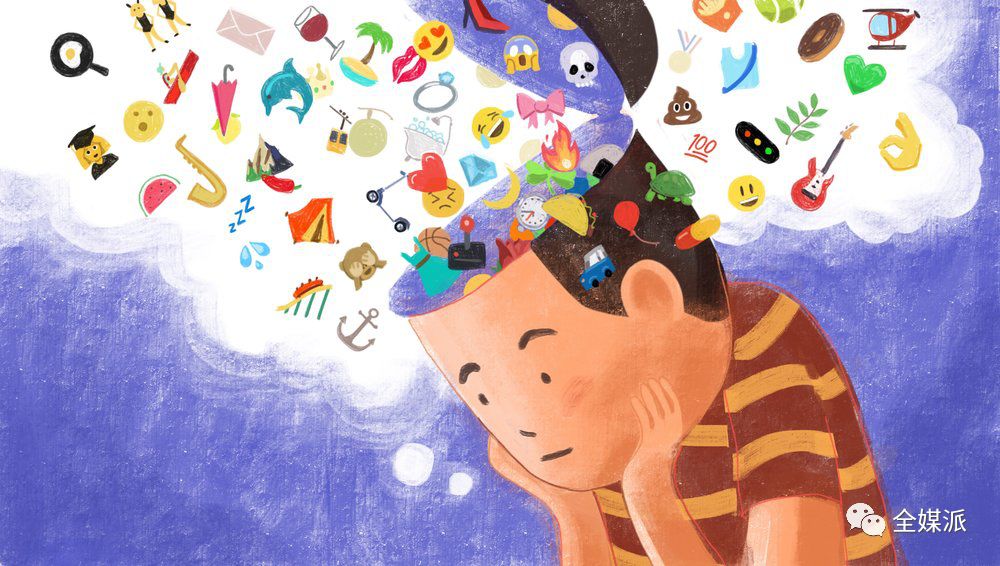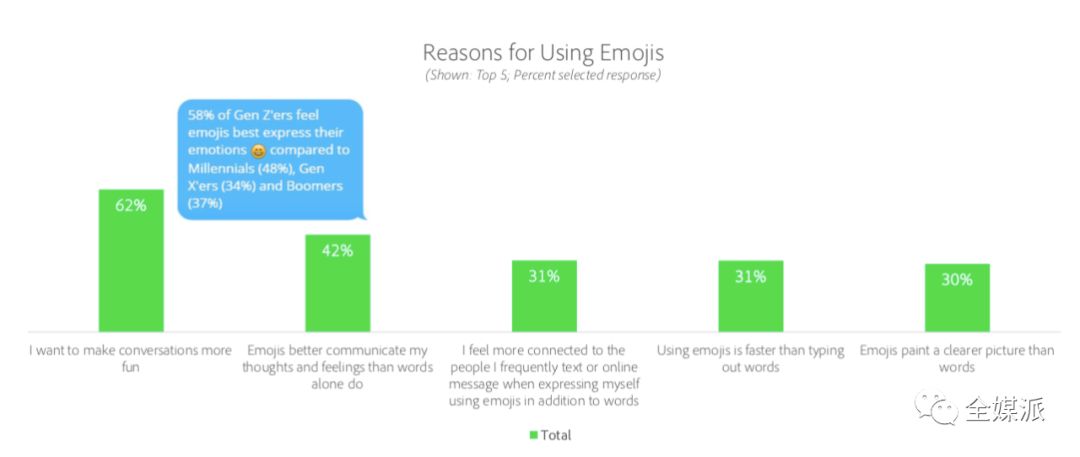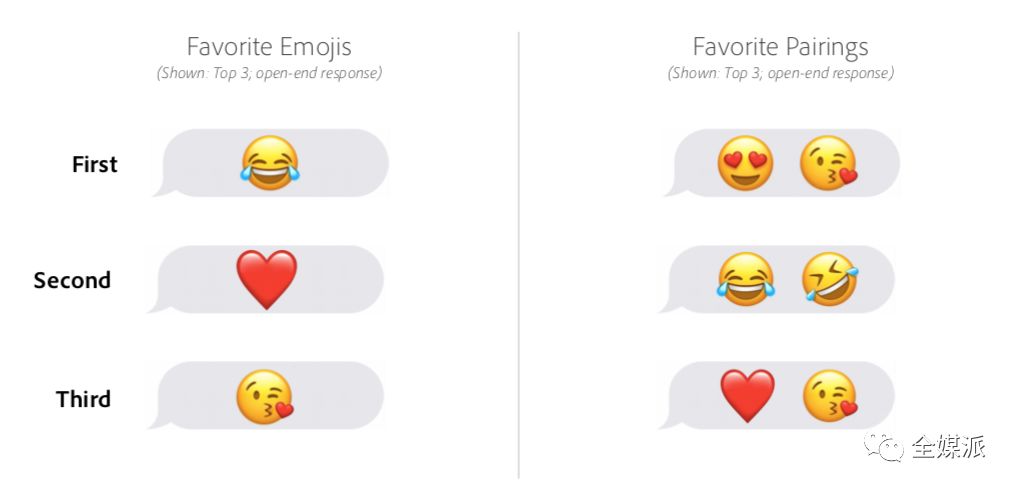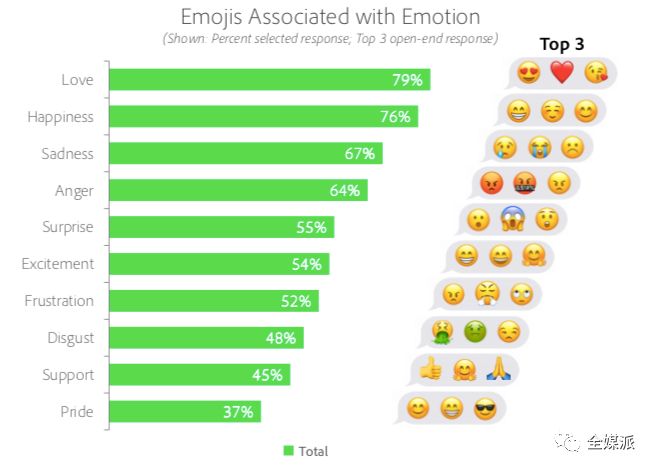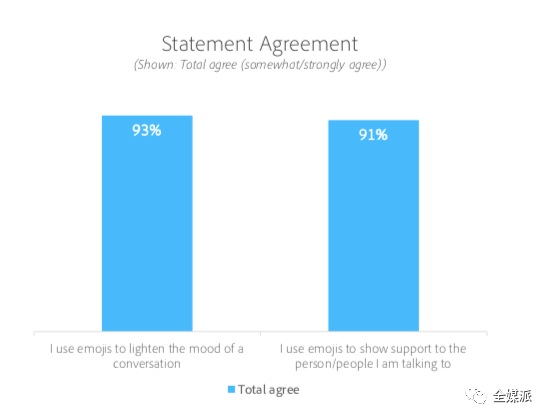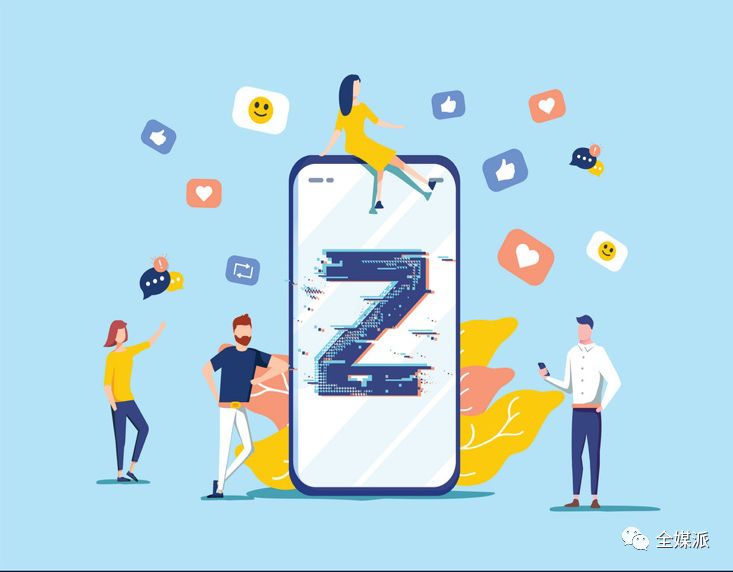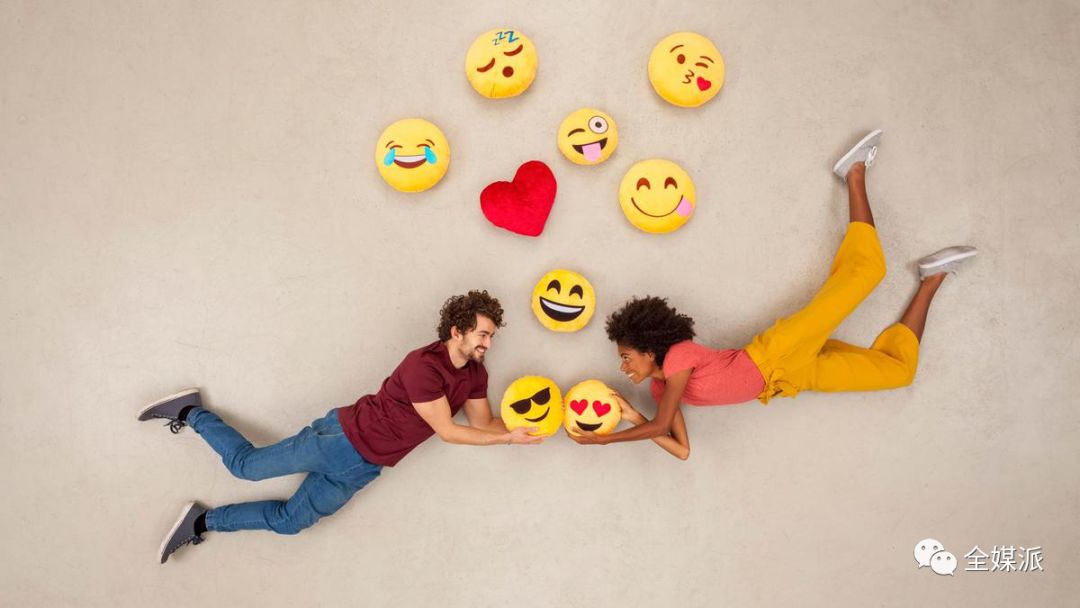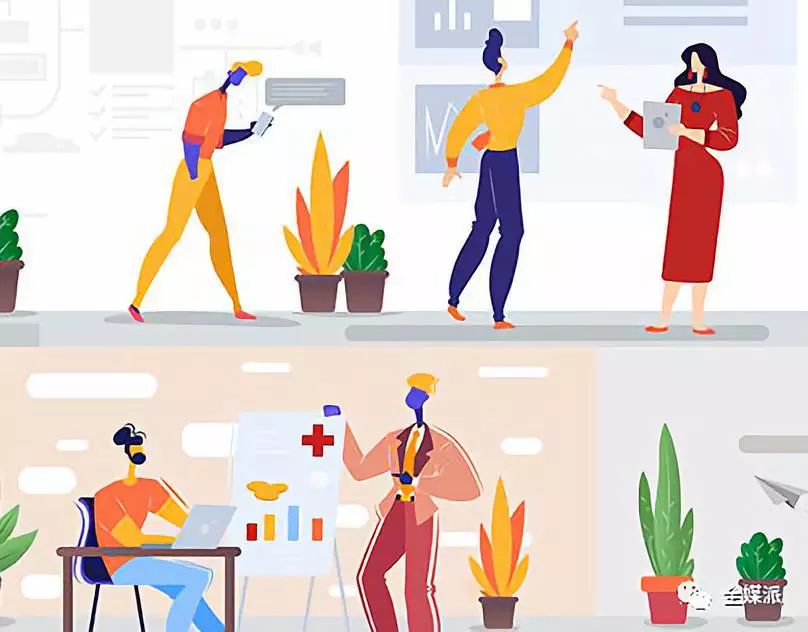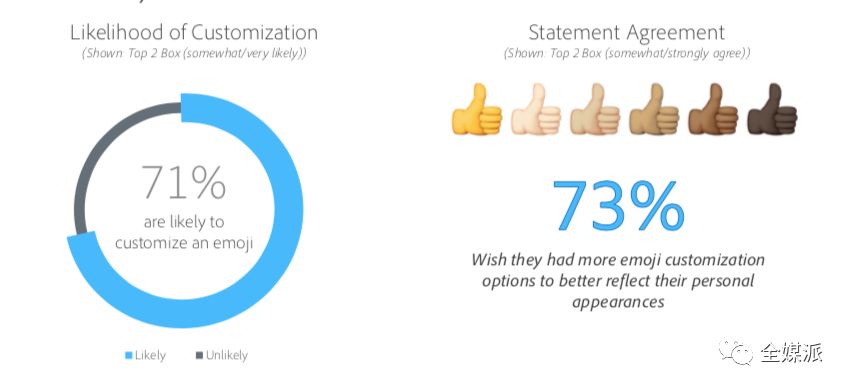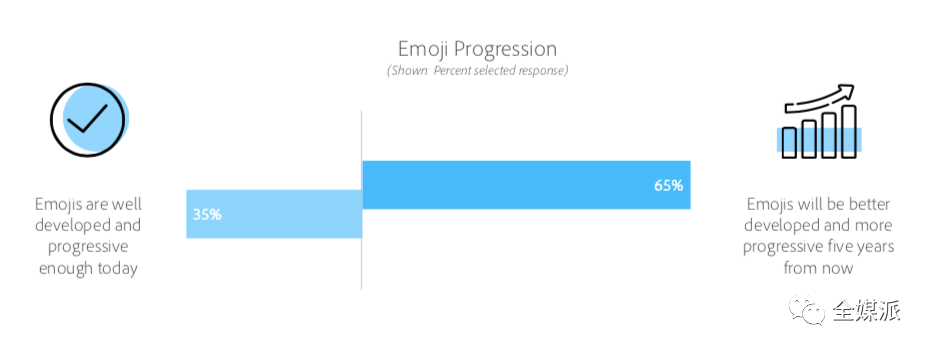Emoji spans language and intergenerational, users have new expectations and imaginations.
Editor’s note: This article is from WeChat public account “All Media Party (ID: Quanmeipai), author of Tencent Media.
People like emoji because it makes conversations more interesting and makes it easier to communicate with others.
Full media article
“The first global language is not English, but Emoji”
Think
After the era of digital culture and printed characters
Emoji is quickly becoming a global language in the true sense.
Today, Emoji is a cultural phenomenon that spans language and intergenerationality and shapes the way we express our thoughts and emotions.
After the arrival of World Emoji Day (July 17th), Adobe conducted an interesting study of 1,000 American emojis between the ages of 16 and 73. Users (these people use emoji at least once a week) conducted a 10-minute online survey,Trying to explore what this new “digital language” has for our lives, relationships, and communication. influences.
Medium Column Author Marcus Swan also referred to Emoji as “the first global language.” This issue of the whole media (ID: quanmeipai) fine editingThis study takes you to see why people are addicted to Emoji and what new expectations and imaginations they have for Emoji.
Why is Emoji so lovable? “Funny” is the key
Making conversations more interesting is the number one reason to use Emoji
In a survey of reasons for using Emoji, 62% of users said they used Emoji to make conversations more interesting, and 42% thought that expression packs are more expressive than words, especially for Generation Z. . In addition, a stronger connection, faster typing speed and clearer picture are also reasons why users like Emoji.
“Laughter,” “Beat” and “Blow Kiss” are users who love Emoi
Among thousands of Emojis, “smile and cry”, “beautiful” and “blow kiss” are the most loved by users. These three emojis are used most frequently, either alone or in combination.
If you look at the level of emoji love from different genders and regions, Adobe finds that crying expressions are unique to men and northeastern American users. Emoji, which ranks among the top three male users, is “smile, cry,” “smile,” and “cry,” and in the northeast, “smile, cry,” “heart,” and “cry.” .
Users express love, happiness, and sadness through Emoji
Adobe also surveyed what emotions users want to express through emoji, and the results show that love, happiness, and sadness rank in the top three. Anger, surprise, excitement, frustration, nausea, support, and pride are also the main emotions that users express through ideograms.
Emoji can ease the dialogue atmosphere and express support /strong>
Surveys show that 93% of users believe that emojis make conversations easier; 91% of users say that emojis express their support for interlocutors.
It’s easier to post than to call
Three-fifths of the users said that they are more comfortable than the phone call, especially for the Z generation. 83% of Generation Z admitted that it is easier for them to express their feelings than to call. In the millennial generation and the “baby boomer generation”, the ratio is 61% and 53%.
*Note: Generation Z, born in the mid-1990s to 2010, is generally influenced by technology products such as the Internet, instant messaging, SMS, MP3, smartphones and tablets. A big generation.
Millennials, a generation that was born in the late 20th century and reached adulthood after entering the 21st century. The growth of this generation is accompanied by the formation and rapid development of the Internet.
Boomers, a generation born after the end of World War II, between 1946 and 1964, more than 75.9 million babies were born in the United States, accounting for about a quarter of the current US population. .
More than just gags, Emoji can also be very serious
In addition to humorous and ambiguous atmosphere, emoji can also be used for big things. 52% of users think that Emoji can be used to expressA milestone event; 45% of users said Emoji could be used to announce a life decision.
From SMS to Social media, Emoji is everywhere
SMS is still the main channel used by Emoji
The study found that text messaging is still the main channel used by Emoji, with 87% of women using Emoji in text messages, compared with 78% of men using Emoji in text messages.
On social media, Facebook (48%) uses Emoji much more than Instagram (21%), Snapchat (18%) and Twitter (6%). Interestingly, the Z generation using emoji on Snapchat and Instagram accounted for 59% and 52%, while the millennial generation did not exceed 30%.
Users have used Emoji for nearly half of their time in chats, and nearly one-third of them use Emoji
surveys, and female users have 55% of their time chatting. The emoji is used, and the male user is 42%. In addition, Generation Z said that they only used Emoji to chat 39% of the time, compared to 24% of the X generation only using Emoji chat.
Expression pack, mainly for friends
87% of users said they would post a love symbol to their friends. 57% of male users said their emoji would be sent to a partner or important friend, compared with 52% in women. At the same time, 24% of male users will express their feelings with colleagues, while females are 14%.
Interestingly, 43% of women said they would post a love sign with their children, compared with 28% of men.
Emoji, God’s Assist in Work
Surveys show that 61% of users also use emoji at work. Among them, 36% of users will only express their feelings to their peers, and 13% of users said that regardless of the level of their colleagues, they will give each other their feelings.
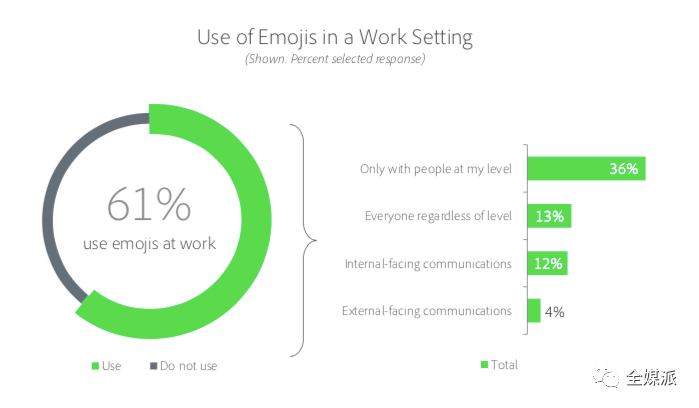
Emoji’s greatest charm – beyond language, efficient communication
In the survey, 94% of users said they like Emoji because it can span the language Obstacles; 90% of users prefer Emoji to be clear and expressive; 87% of users say they use Emoji to emphasize a certain point, not to replace text. In addition, the word fee is less, more cordial, etc., which is why users like Emoji.
About Emoji, more imagination and expectation
Emoji Magnum? Actually, there are regrets
Emoji is rich and easy to use, but it is not omnipotent.
60% of users believe that emoji is sometimes generic and does not reveal personality; 59% of users say they have received erroneous emoji; 57% of users think emoji sometimesInsincere; 56% of users said that the existing emoji is not rich enough to express emotions vividly.

Users expect more Emoji
76% of users hope that more Emoji will be available in the future. The emoji of food/beverage/snacks is the most anticipated, and users expect more emoji to choose from, especially Asian food. In addition, animal/insect, emotion, and gesture emoji are also expected by users.
Personalization is subject to time
To stay The survey found that 71% of users have the habit of “customizing” Emoji, such as turning a gesture into their own skin tone. And 73% of users said they hope that Emoji will have more customized options in the future to better demonstrate the user’s personality.
Hair styling/color and dynamism are the most popular among many customizations. Among them, 61% of Z generations and 50% of millennials believe that the personalization of hair styles can better reflect their appearance; while 53% of baby boomers prefer dynamic operation.
Emoji brings new opportunities to brand marketing
Adobe found that Emoji isBrand marketing is also an “artifact.”
60% of users said that if a brand or company uses emoji that matches their personality, their favor for the brand will rise; 51% of users say they will use emoji Brand social media comments; 48% of users said they are more likely to focus on those using emoticons
Brand account number;
Another 44% said they prefer to buy brands that use emoji in their ads.
Additional, 58 % of users indicated that they would prefer to click on branded emails with emoji in their titles. If the title has their favorite emoji, 75% of the Z generations are willing to open the mail, and in the millennial, X generation and baby boomers, the proportions are 63%, 59% and 65% respectively.
Emoji, broad frontier
“inclusivity” is one of the most mentioned words when investigating user expectations for Emoji’s future. 78% of users believe that Emoji should continue to broaden its inclusiveness and expect more emoji to express users’ thoughts and emotions.
When asked about the future development of Emoji, most users gave positive feedback.
35% of users think that Emoji has reached the ceiling;
Another 65% of users believe that Emoji will continue to grow in the next five years.
From generation Z, to the millennial generation, to the baby boomer generation, Emoji has crossed the generation gap and attracted users of all ages. Behind the simple surface of Emoji, there are countless meanings and functions – it can be a funny and funny tool between young friends, or a magic weapon to ease the atmosphere in serious work; it can be used to announce a life decision. It can also be just a simple smile; it can express support to friends, or it can become an artifact of brand marketing to stimulate users to buy…
is rich in meaning and direct in expression, and Emoji is gradually becoming the most common global language in the Internet age. When users love Emoji, they are also in use.Constantly give it new meaning and propose new expectations.
In the future, will Emoji become more inclusive and rich? The answer is worth our expectation.
